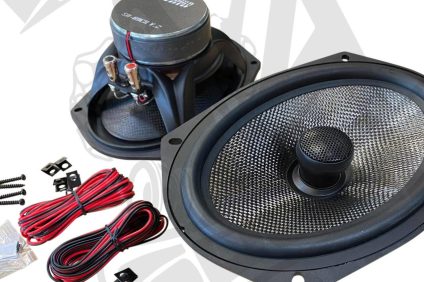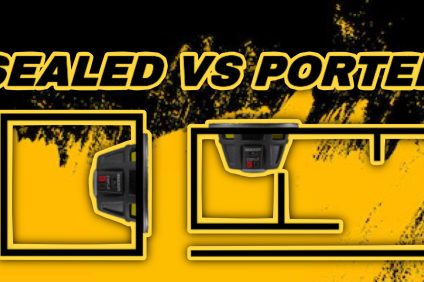If you are running high-powered amplifiers in your car audio setup, chances are or will be running multiple batteries as well. The added batteries, along with a high-output alternator, will provide the necessary power needed to keep your amplifiers running at their optimum performance. But, did you know that if your extra batteries are not isolated from your main battery, they can drain your main battery? This can inhibit you from starting your engine and using other functions of your vehicle.
But how do you managing your extra batteries and control the parasitic draw that comes with running multiple batteries? The answer to this question is quite simple; isolators or separators. Depending on your setup and the goals of your auxiliary battery system, will determine which one of these devices you should use within your build, because they may seem like they are similar, but they actually function quite differently.
In this post, we will go over what isolators and separators are and what their purpose is in a multi-battery setup is.
Isolators

Isolators are considered a distribution point for the electrical system in your vehicle. Isolators are constructed with diodes, which ensures the charge from the alternator is distributed evenly between all of the batteries in a vehicle.
Most car audio setups will rely on at least two batteries to function. One primary battery, normally used to start the vehicle and to run the factory accessories and a second battery to power the amplifier(s). The problem with a multiple battery system, such as this, is that issues start to arise when a fully charged battery is connected to a partially charged or completely dead battery. The current from the fully charged battery will begin to move to the battery with the lesser charge until both batteries reach a level, common charge, or completely discharge altogether.
This parasitic drain will continue until an isolator has been installed. As stated previously, the isolator’s purpose is to evenly distribute the alternator’s charging current evenly between all of the batteries in the system in which each battery receives the charge needs based on its current charged level. In addition, an isolator’s diodes ensure the current from the alternator only moves in one direction, thus eliminating the current from leaving one battery to another and also stops other loads in the charging system from draining the primary battery.
In a setup where an isolator is used, each battery is isolated from the other and is used as an independent power source which allows the primary battery to conserve its charge for starting the vehicle and running the factory accessories.
Separators

Separators are very different, functionality-wise, from battery isolators. They operate more like a switch that can direct current to the batteries within a system. The main difference between the isolator and the separator is that a separator can prioritize charging. It will allow the alternator to charge the primary battery first and then the auxiliary batteries.
So how does the separator function? As the engine is running, the separator will monitor the voltage of all the batteries in the system. If the separator finds insufficient voltage from any battery, it will activate a solenoid to allow current to flow from one of the auxiliary batteries to make up for the drop in voltage.
If a separator sees that the system voltage is beginning to drop below a set threshold, the separator will disconnect the primary battery from the auxiliary bank to protect all of the batteries from the excessive drain. To avoid a situation such as this is imperative that the voltage be monitored closely through the use of voltage meters or audible warning.
A separator can assist a vehicle when the primary battery has an insufficient charge to start a vehicle. If the separator notices the primary battery’s voltage is too low, the separator will open the auxiliary battery bank to aid in starting the vehicle. The separator allows for current to flow in multiple directions, unlike the isolator, which can allow for the auxiliary batteries to charge the other batteries within the charging system. Be aware, a separator does not provide the same protection against parasitic draw as an isolator, so the batteries could be potentially drained if not monitored closely.
Which is Best for Car Audio?
In most car audio setups, there is little need for the auxiliary batteries to aid in charging the primary, or other batteries. In a car audio system that contains multiple batteries, an isolator would be the best choice to maintain the battery system. Because an isolator only allows the current to flow in one direction, you will not have to disconnect your second battery or battery bank when the vehicle has been turned off.
An isolator requires no power when the vehicle is not in use, whereas a separator will draw some current while the vehicle is not running. That said, the isolator is ideal for car audio setups because it offers more protection than a separator.
Conclusion
No matter how many batteries you are running in your car audio system, an isolator, or isolators, are imperative for the proper management and protection of the vehicle’s charging and battery system.
NOTE: Before installing high-output alternators, isolators, or a multiple-battery system in your vehicle, be sure to perform the BIG 3 upgrade and ensure you are using the correct size wire for your system’s needs. I discussed how to perform the BIG 3 upgrade HERE.
Shop DOWN4SOUNDSHOP.COM for all your favorite car audio brands. Experience the DOWN4SOUND DIFFERENCE.
- Lowest possible prices on all your favorite car audio brands
- We stock the most products in our warehouse
- The best customer service in the industry
- Free shipping
- Financing plans available
- Free goodies with every order!
DISCLAIMERS:
** Please note that this article provides general information on isolators and separators in a vehicle’s battery system. Keep in mind that not all vehicles are the same and may require different installation methods and techniques to ensure a safe and effective install. By no means, am I a professional mechanic or car audio installer, and D4S and I, are not liable for any damages cause to your person or vehicle by following these instructions. Please consult a professional if you have any questions or concerns regarding your own vehicle and how to perform modifications such as the one explained in the previous statements.




Pingback: Adding A Second Battery